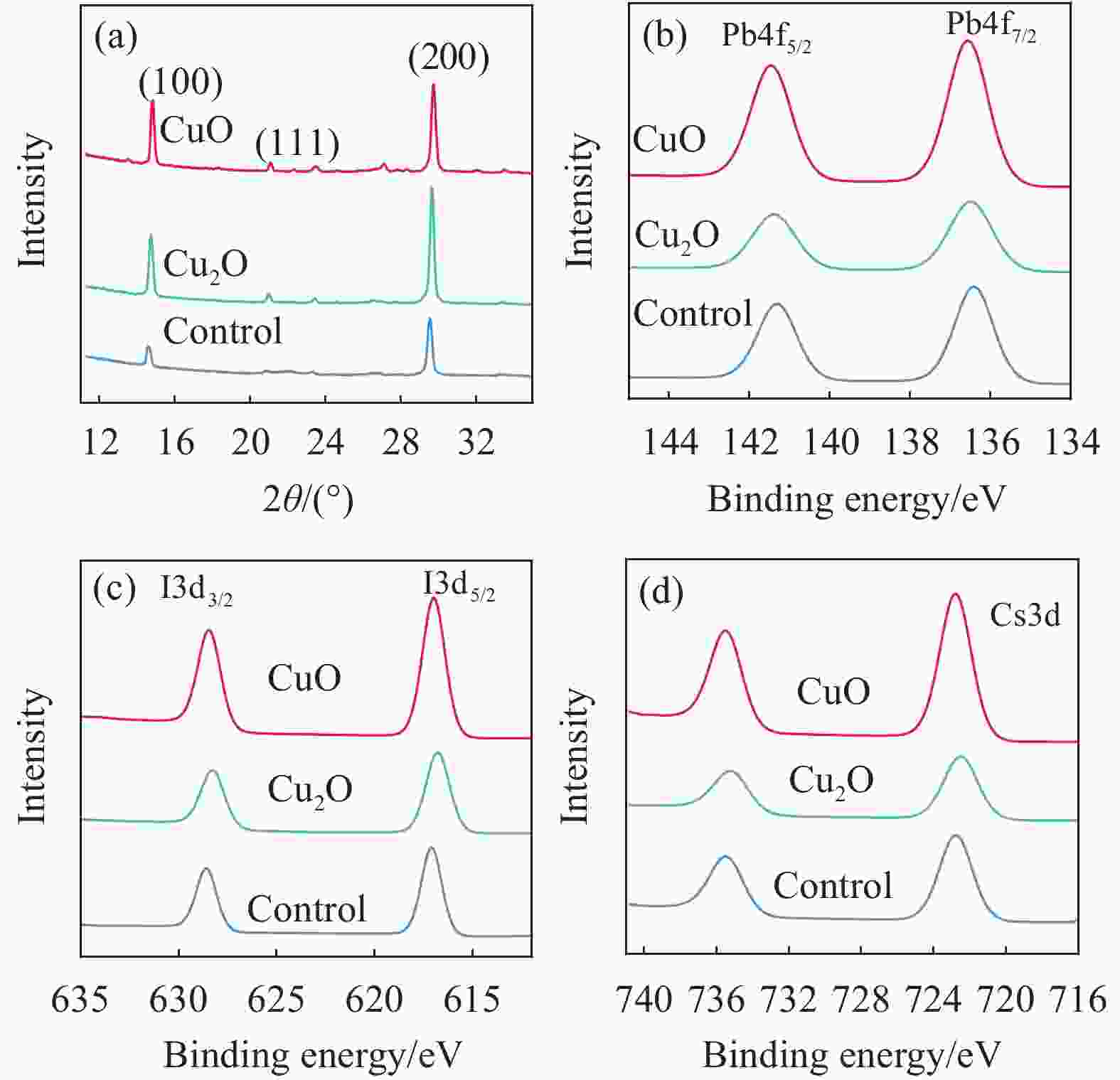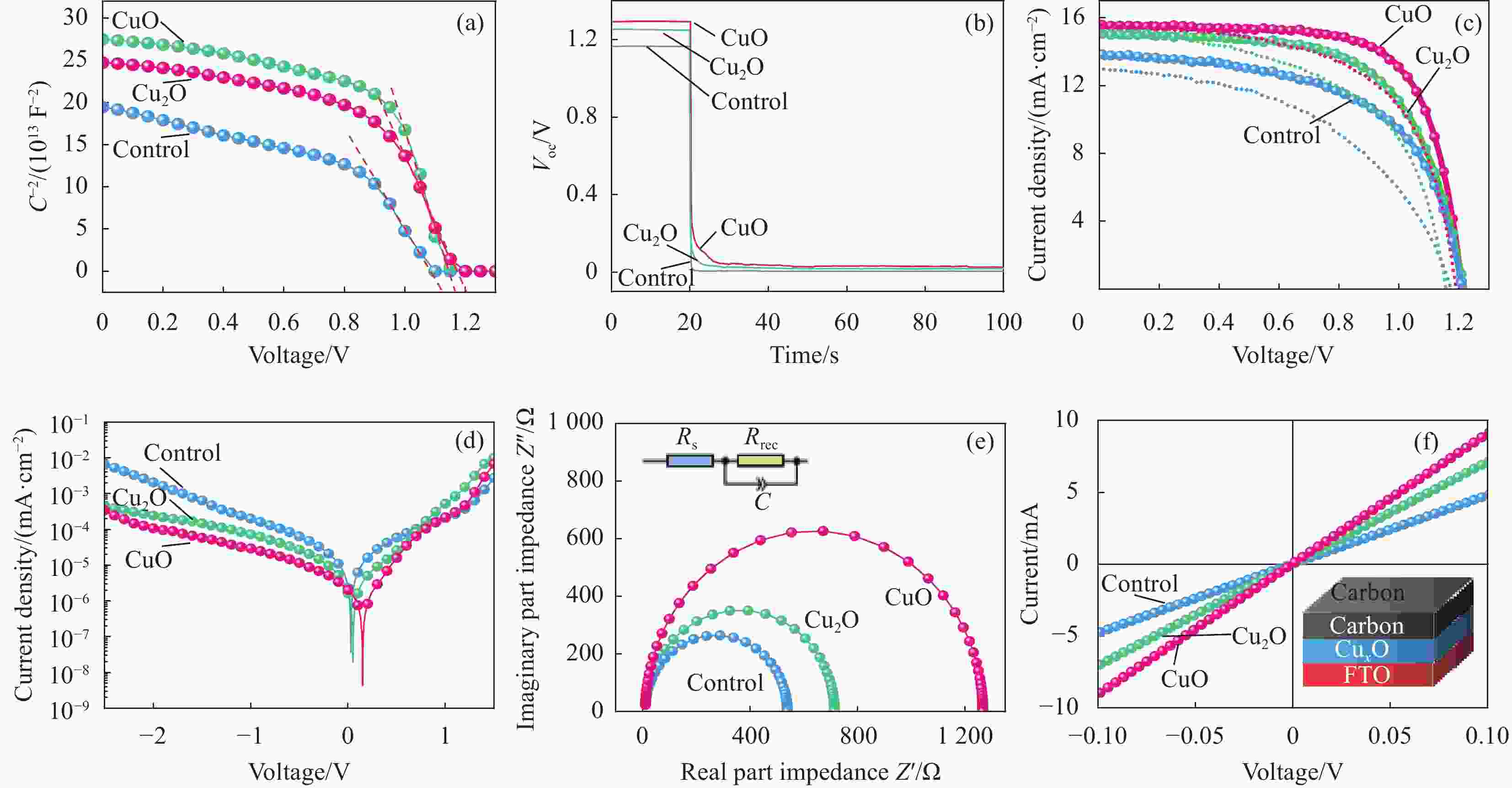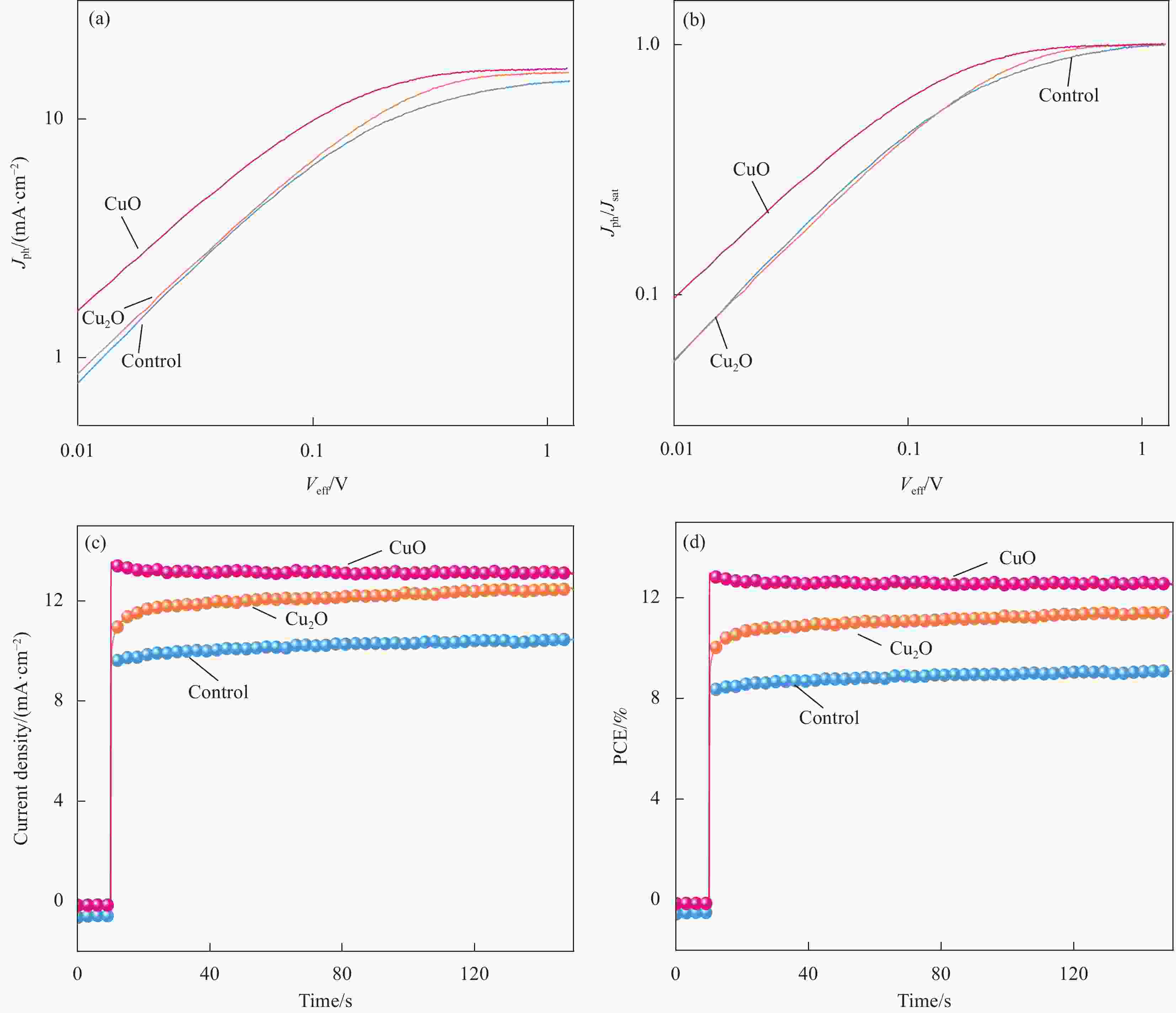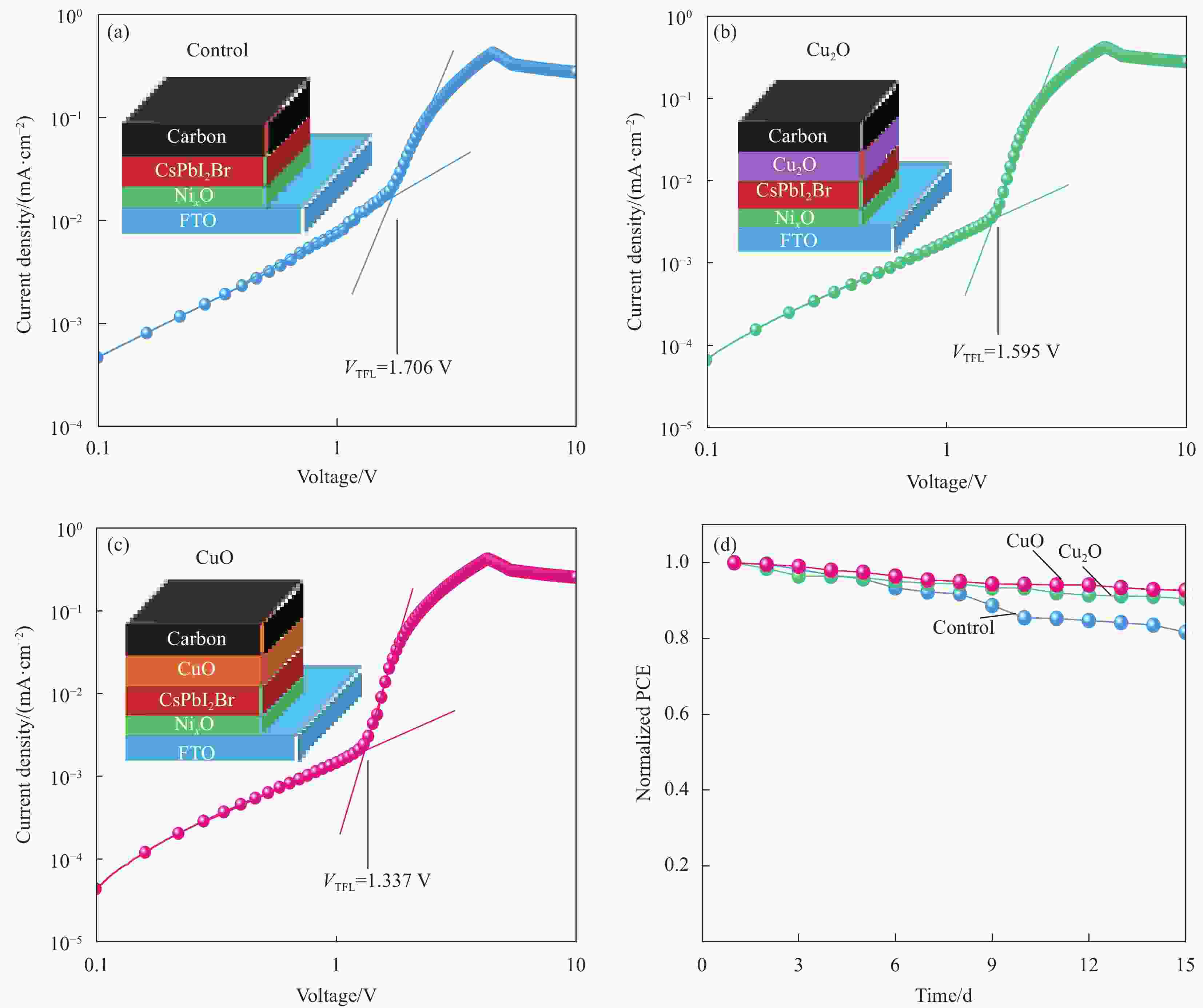Improved interface performance of all inorganic carbon based CsPbI2Br perovskite solar cells using CuxO
-
摘要: 基于CsPbI2Br的全无机碳基钙钛矿太阳能电池由于碳电极与钙钛矿层间接触性能较差和能带不匹配等问题,导致其光电转化效率较低。本文采用简单的葡萄糖还原法结合煅烧技术制备了两种不同形貌和结构的规则八面体构型CuxO,将之作为无机空穴传输材料,制备了结构为导电玻璃(FTO)/SnO2/CsPbI2Br/CuxO/C的碳基钙钛矿太阳能电池,研究了CuO和Cu2O的形貌、结构对光电性能的影响机制。结果显示:CuO和Cu2O皆具有良好的化学稳定性和p型载流子传输特性,可有效增强CsPbI2Br钙钛矿层与碳电极层之间的界面接触,改善载流子传输性能,减少电荷复合,延长光电子寿命。基于Cu2O和CuO的CsPbI2Br基碳基钙钛矿太阳能电池(C-PSC)器件的光电转换效率最高分别为11.62%和13.22%,分别比空白对照器件的光电转化效率提高了19.5%和36.0%。此外,通过添加Cu2O和CuO,器件在空气中的长期稳定性也得到明显改善,该工作为提高碳基CsPbI2Br钙钛矿太阳能电池的光电性能提供了一种简单有效的方法。
-
关键词:
- 无机钙钛矿太阳能电池 /
- CuxO /
- CsPbI2Br /
- 转化效率 /
- 无机空穴传输材料
Abstract: All inorganic carbon-based CsPbI2Br perovskite solar cells (C-PSCs) have lower photoelectric conversion efficiency due to poor contact performance and mismatch of energy band between carbon electrode and perovskite laye. In this paper, two kinds of regular octahedral CuxO with different morphologies and structures were prepared by a simple glucose reduction method combined with calcination technology. As inorganic hole transport materials, C-PSCs with the structure of conductive glass (FTO)/SnO2/CsPbI2Br/CuO/C were prepared and the influence of morphologies and structures on the photoelectric performance was studied. The results show that CuxO has good chemical stability and p-type carrier transport characteristics, which can effectively enhance the interface contact between CsPbI2Br and carbon electrode, improve the carrier transport performance, reduce charge recombination, and extend the photoelectron life. The highest photoelectric conversion efficiency of CsPbI2Br based C-PSCs devices based on Cu2O and CuO is 11.62% and 13.22%, respectively, which is 19.5% and 36.0% higher than that of blank devices. In addition, by adding Cu2O and CuO, the long-term stability of the device in the air is also significantly improved. This work has a certain significance for improving the performance of CsPbI2Br based C-PSCs.1) 孙北、郑申申为共同第一作者,对本文具有同等效力 -
图 5 (a)莫特-肖特基图(电容(C−2)-电压)曲线;(b) 开路电压衰减(OCVD)曲线;(c)正反扫光电流密度-电压 (J-V)曲线;(d)暗态下的光电流密度-电压 (J-V)曲线;(e) 电化学阻抗谱(EIS)曲线和电路模拟图;(f)基于FTO/C和FTO/CuxO/C结构的导电率
Voc—Open circuit voltage; Rs—Series resistance; Rrec—Charge recombination resistance; C—Capacitance; FTO—Conducting glass
Figure 5. (a) Mott-Schottky plot (Capacitance (C−2)-voltage); (b) Open circuit voltage decay (OCVD) curves; (c) Forward and reverse photocurrent density voltage (J-V) measurement; (d) Photocurrent density-voltage (J-V) curves under dark condition; (e) Electrochemical impedance spectroscopy (EIS) curves and circuit simulation diagram; (f) Conductivity based on FTO/C and FTO/CuxO/C structure
图 6 (a)光电流密度(Jph)曲线;(b) CsPbI2Br PSC的Jph/Jsat曲线;(c)器件的稳态电流密度输出; (d)稳态 PCE 输出曲线
Figure 6. (a) Photocurrent density Jph curves; (b) Jph/Jsat plots of CsPbI2Br PSC; (c) Current density of steady-state output; (d) Steady-state PCE output
Veff—Voltage effective value; Jph—Photocurrent density; Jsat—Dark saturation current density
表 1 CsPbI2Br钙钛矿太阳能电池(PSCs)的光电性能参数
Table 1. Photovoltaic parameters of CsPbI2Br perovskite solar cells (PSCs)
Voc/V Jsc/(mA·cm−2) FF PCE/% HI Control RS 1.21 13.60 0.59 9.72 0.34 FS 1.18 12.68 0.50 7.50 Cu2O RS 1.22 14.95 0.64 11.62 0.16 FS 1.16 14.90 0.57 9.80 CuO RS 1.21 15.55 0.70 13.22 0.15 FS 1.19 15.41 0.61 11.21 Notes: RS—Reverse scan; FS—Forward scan; Voc—Open-circuit voltage; Jsc—Short-circuit current density; FF—Fill factor; PCE—Power conversation efficiency; HI—Hysteresis index. -
[1] SUTTON R J, EPERON G E, MIRANDA L, et al. Bandgap-tunable cesium lead halide perovskites with high thermal stability for efficient solar cells bandgap-tunable cesium lead halide perovskites with high thermal stability for efficient solar cells[J]. Advanced Energy Materials,2016,6(8):1502458. doi: 10.1002/aenm.201502458 [2] CHEN G, LI P, XUE T, et al. Design of low landgap CsPb1-xSnxI2Br perovskite solar cells with excellent phase stability[J]. Small,2021,17(30):2101380. doi: 10.1002/smll.202101380 [3] WANG Y, QUINTANA X, KIM J, et al. Phase segregation in inorganic mixed-halide perovskites: From phenomena to mechanisms[J]. Photonics Research,2020,8(11):402411. [4] NOH J H, IM S H, HEO J H, et al. Chemical management for colorful, efficient, and stable inorganic-organic hybrid nanostructured solar cells[J]. Nano Letters,2013,13(4):1764-1769. doi: 10.1021/nl400349b [5] ZHOU Y, ZHANG X, LU X, et al. Promoting the hole extraction with Co3O4 nanomaterials for efficient carbon-based CsPbI2Br perovskite solar cells[J]. Solar RRL,2019,3(4):1800315. doi: 10.1002/solr.201800315 [6] BAI D, ZHANG J, JIN Z, et al. Interstitial Mn2+-driven high-aspect-ratio grain growth for low-trap-density microcrystalline films for record efficiency CsPbI2Br solar cells[J]. ACS Energy Letters, 2018, 3(4): 970-978. [7] ZHAO Y, XU H, WANG Y, et al. 10.34%-efficient integrated CsPbBr3/bulk-heterojunction solar cells[J]. Journal of Power Sources,2019,440:227151. doi: 10.1016/j.jpowsour.2019.227151 [8] STOUMPOS C C, KANATZIDIS M G, The renaissance of halide perovskites and their evolution as emerging semiconductors[J]. Accounts of Chemical Research, 2015, 48(10): 2791-2802. [9] CHUNG I, SONG J, IM J, et al. CsSnI3: Semiconductor or metal? High electrical conductivity and strong near-infrared photoluminescence from a single material. High hole mobility and phase-transitions[J]. Journal of the American Chemical Society,2012,134(20):8579-8587. doi: 10.1021/ja301539s [10] DASTIDAR S, EGGER D A, TAN L A, et al. High chloride doping levels stabilize the perovskite phase of cesium lead iodide[J]. Nano Letters,2016,16(6):3563-3570. doi: 10.1021/acs.nanolett.6b00635 [11] KUAN C, SHEN H, LIN C. Low photoactive phase temperature all-inorganic[J]. RSC Advances,2021,11:3264-3271. [12] DU Y, TIAN Q, CHANG X J, et al. Ionic liquid treatment for highest-efficiency ambient printed stable all-inorganic CsPbI3 perovskite solar cells[J]. Advanced Materials,2022,34(10):2106705. [13] ZENG Q, ZHANG X, FENG X, et al. Polymer-passivated inorganic cesium lead mixed-halide perovskites for stable and efficient solar cells with high open-circuit voltage over 1.3 V[J]. Advanced Materials,2018,30(9):1705393. doi: 10.1002/adma.201705393 [14] FU S, ZHANG W, LI X, et al. Dual-protection strategy for high-efficiency and stable CsPbI2Br inorganic perovskite solar cells[J]. ACS Energy Letters,2020,5(2):676-684. doi: 10.1021/acsenergylett.9b02716 [15] YANG S, ZHAO H, HAN Y, et al. Europium and acetate co-doping strategy for developing stable and efficient CsPbI2Br perovskite solar cells[J]. Small,2019,15(46):1904387. doi: 10.1002/smll.201904387 [16] QIU J, YANG S. Material and interface engineering for high-performance perovskite solar cells: A personal journey and perspective[J]. The Chemical Record, 2020, 20(3): 209-229. [17] SALIBA M, CORREA-BAENA J P, WOLFF C M, et al. How to make over 20% efficient perovskite solar cells in regular (n-i-p) and inverted (p-i-n) architectures[J]. Chemistry of Materials,2018,30(13):4193-4201. [18] PATTANASATTAYAVONG P, NDJAWA G O N, ZHAO K, et al. Electric field-induced hole transport in copper(I) thiocyanate (CuSCN) thin-films processed from solution at room temperature[J]. Chemical Communications,2013,49(39):4154-4156. doi: 10.1039/C2CC37065D [19] BYRANVAND M M, KIM T, SONG S, et al. p-type CuI islands on TiO2 electron transport layer for a highly efficient planar-perovskite solar cell with negligible hysteresis[J]. Advanced Energy Materials,2018,8(5):1702235. doi: 10.1002/aenm.201702235 [20] KIM J H, LIANG P W, WILLIAMS S T, et al. High-performance and environmentally stable planar heterojunction perovskite solar cells based on a solution-processed copper-doped nickel oxide hole-transporting layer[J]. Advanced Materials,2015,27(4):695-701. doi: 10.1002/adma.201404189 [21] ZUO C, DING L. Solution-processed Cu2O and CuO as hole transport materials for efficient perovskite solar cells[J]. Small,2015,11(41):5528-5532. doi: 10.1002/smll.201501330 [22] LI Q, WANG F, SUN L, et al. Design and synthesis of Cu@CuS yolk-shell structures with enhanced photocatalytic activity[J]. Nano-Micro Letters,2017,9(3):35. doi: 10.1007/s40820-017-0135-7 [23] UMA B, ANANTHARAJU K S, RENUKA L, et al. Controlled synthesis of (CuO-Cu2O)Cu/ZnO multi oxide nanocomposites by facile combustion route: A potential photocatalytic, antimicrobial and anticancer activity[J]. Ceramics International,2021,47(10):14829-14844. doi: 10.1016/j.ceramint.2020.09.223 -





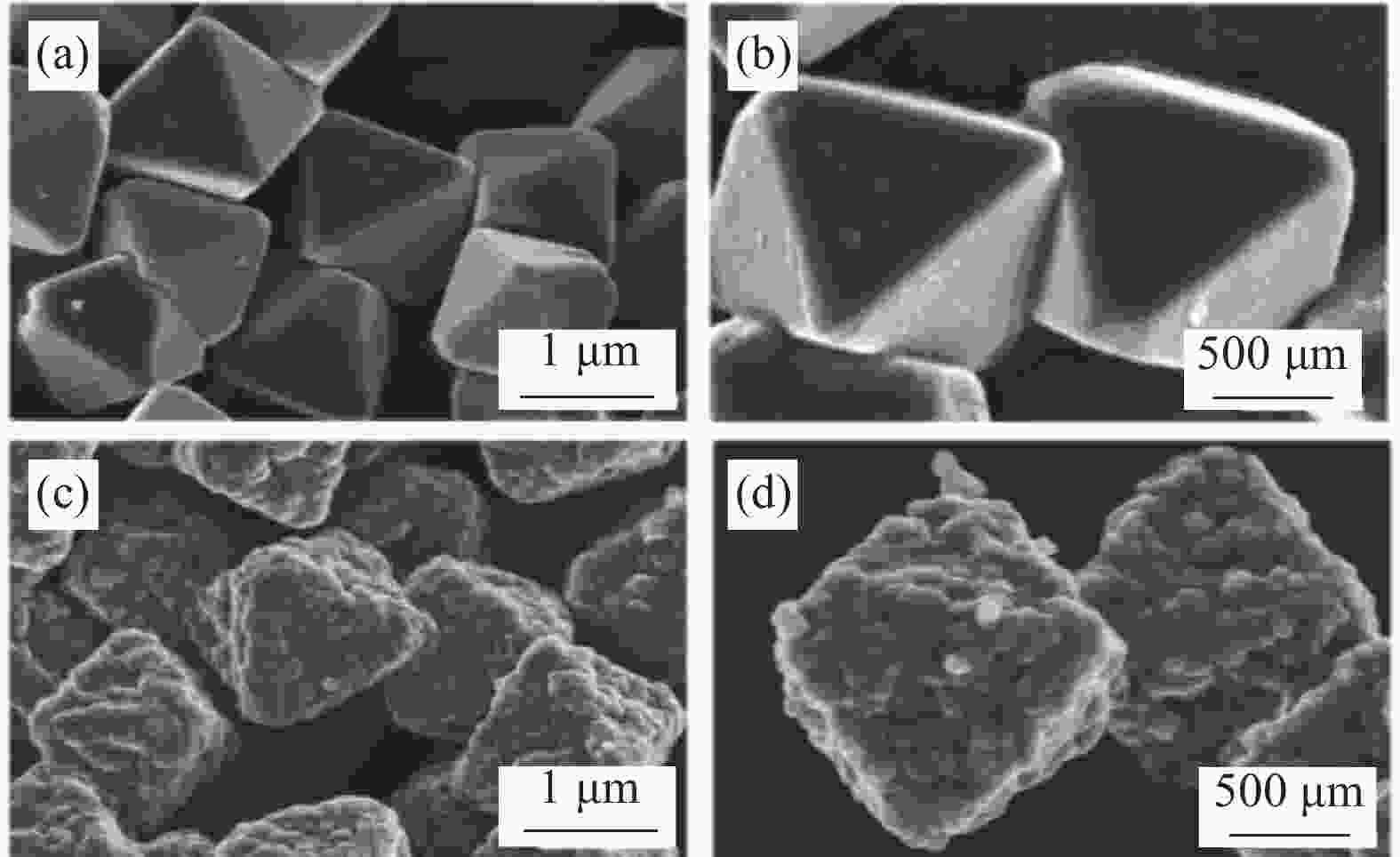
 下载:
下载:

